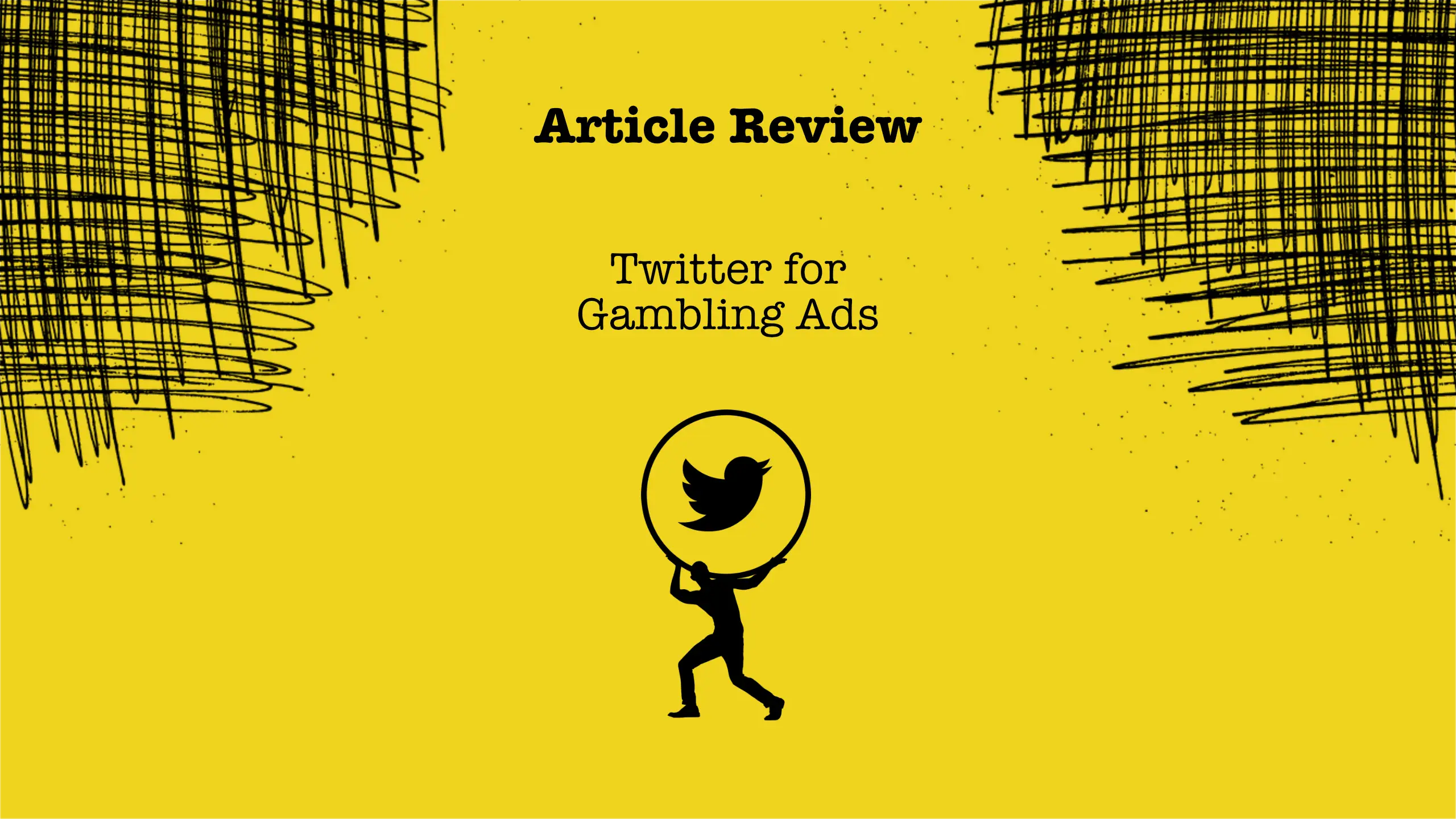Social media has revolutionized the way gambling is promoted.
In How Are Major Gambling Brands Using Twitter? (Bradley & James, 2019), the authors analyze how major gambling operators use Twitter as a marketing and engagement tool — not just to advertise bets, but to normalize gambling as an everyday leisure activity.
The study provides an in-depth analysis of tweet frequency, message content, and marketing strategies across leading operators such as Bet365, Ladbrokes, William Hill, Betfair, and Coral. It highlights how these brands frame gambling as fun, glamorous, and socially engaging, while minimizing the risks and harms associated with betting.
Key Concepts
1. Social Media as a Gambling Marketing Tool
Twitter’s speed, interactivity, and reach make it an ideal platform for gambling operators. The immediacy of sports events aligns perfectly with the platform’s real-time nature, allowing companies to:
- Promote in-play bets during matches,
- Encourage spontaneous engagement, and
- Target users at emotionally heightened moments.
“Twitter’s timeliness is beneficial for gambling companies to reach specific segments of the population.”
This immediacy also amplifies risk exposure, particularly among young audiences and problem gamblers, who are more likely to act impulsively.
2. Tone, Style, and Emotional Framing
Gambling-related tweets typically employ positive emotional language — evoking anticipation, excitement, and joy.
Tweets portray betting as:
- Glamorous (“big wins,” “exclusive offers”),
- Effortless (“easy odds,” “one tap to bet”), and
- Socially embedded (“join the action,” “don’t miss out”).
Words associated with trust and pleasure dominate, masking the financial risks of gambling behind an entertainment narrative.
“Adverts portray gambling as a glamorous and exciting activity with ease of winning money.”
3. Hashtags and Viral Engagement
Hashtags play a central role in gambling operators’ Twitter strategies. They serve as campaign anchors, competition identifiers, and engagement triggers.
Examples include:
#365HigherOrLower#365ChipCount#PaddyPileUp
Such hashtags not only encourage interaction but also create brand communities, reinforcing social belonging around gambling behavior.
Even responsible gambling tags (e.g., Betfair’s #WhenTheFunStopsStop) are sometimes used alongside promotional content, diluting the seriousness of their intended message.
4. Visuals, Humor, and User-Generated Content
Different gambling operators adopt distinct communication styles:
- Bet365 and Coral emphasize visual content — gifs, match highlights, and infographics — to stimulate engagement.
- William Hill and Ladbrokes focus more on direct interactions with user requests and commentary.
Humor, memes, and viral references are common.
This playful tone softens perceptions of risk, while user-generated content (e.g., fans’ “lucky wins” or bet slips) fosters an illusion of participation and success.
“Companies employ viral content and humour to reach out to a wider audience and utilize user-generated content to enhance customer relationships.”
5. The Normalization of Gambling
Frequent exposure to gambling-related tweets contributes to the normalization of betting.
By embedding gambling in everyday discourse — sports updates, memes, and pop culture — operators subtly shift betting from a high-risk activity to a social pastime.
“The frequency of gambling adverts could normalize gambling as an everyday part of normal life.”
This normalization process is especially problematic for problem gamblers, who are more sensitive to gambling cues and may relapse or increase betting behavior upon exposure.
Studies (Clemens et al., 2017; Binde & Romild, 2018) confirm that social media advertising heightens gambling intention and consumption, particularly among young people.
6. Engagement and Retention Strategies
Twitter serves dual marketing goals:
- Engagement and Retention – sustaining existing customers through humor, competitions, and insider content.
- Acquisition – targeting new users through trending hashtags and match-time promotions.
Operators often tie promotions to real-time sporting events, creating time-sensitive pressure (“bet now,” “don’t miss your chance”).
This encourages impulse betting, particularly when linked to live sporting moments.
7. Risks of Continuous Exposure
The study raises ethical concerns about the constant presence of gambling content in users’ feeds.
Followers are exposed to repeated reminders of betting opportunities, often framed as harmless fun.
This continuous exposure can:
- Trigger relapse among recovering problem gamblers,
- Reinforce gambling-related cognitive distortions, and
- Encourage excessive or impulsive betting among regular users.
Public health researchers warn that such marketing blurs the line between information and persuasion, particularly on unregulated social platforms.
Summary of Findings
| Marketing Element | Purpose | Observed Effect |
|---|---|---|
| Positive Emotion Framing | Make gambling appear fun and safe | Encourages engagement and optimism bias |
| Hashtags & Competitions | Drive viral reach and user participation | Build community and normalize gambling |
| Visual & Humorous Content | Entertain and attract young audiences | Lowers perceived risk |
| Real-Time Promotions | Leverage live events for spontaneous bets | Promotes impulsive behavior |
| User-Generated Content | Showcase wins and fan stories | Enhances illusion of control and success |
| Responsible Gambling Tags | Regulatory compliance | Often overshadowed by marketing context |
Academic Reference
Bradley, A., & James, R. (2019). How are major gambling brands using Twitter? International Gambling Studies, 19(1), 1–20.
External References
- Binde, P., & Romild, U. (2018). Self-reported negative influence of gambling advertising in a Swedish population-based sample. Journal of Gambling Studies, 34(3), 911–929.
- Clemens, F., Hanewinkel, R., & Morgenstern, M. (2017). Exposure to gambling advertisements and gambling behavior in young people. Journal of Gambling Studies, 33(1), 1–13.
- Deans, E. G., Thomas, S. L., Daube, M., Derevensky, J., & Gordon, R. (2016). Creating symbolic cultures of consumption: An analysis of the content of sports wagering advertisements in Australia. BMC Public Health, 16(1), 1–10.
- Gainsbury, S. M., Hing, N., Delfabbro, P. H., Dewar, G., & King, D. L. (2016). An exploratory study of gambling operators' use of social media and the latent messages conveyed. Journal of Gambling Studies, 32(1), 125–141.
- Hing, N., Cherney, L., Blaszczynski, A., Gainsbury, S. M., & Lubman, D. I. (2014). Do advertising and promotions for online gambling increase gambling consumption? International Gambling Studies, 14(3), 394–409.
